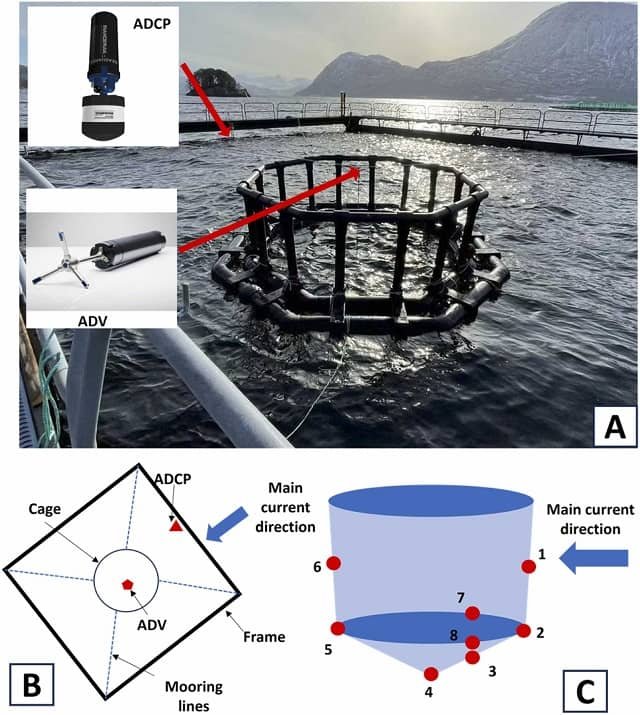Growing environmental concerns surrounding open-sea cage aquaculture for Atlantic salmon have driven the development of innovative commercial-scale semiclosed marine systems for the rearing of post-smolt Atlantic salmon (100-1000 g).
Determining the optimal specific mass water flow requirements for post-smolts is crucial for designing and sizing these systems effectively.
In this regard, a team of scientists from the Norwegian Institute for Water Research, the University of Bergen, MOWI ASA, Akvaplan-niva, Nofima, among other academic organizations, documented the potential effects of reduced specific water flow on performance and welfare at a population density of 75 kg m-3.
Design and Experimental Methodology
To investigate the effects of water flow on post-smolt Atlantic salmon, scientists conducted a controlled experiment. Post-smolts were randomly assigned to four treatment groups, each subjected to a specific water flow rate: 0.2, 0.3, 0.4, or 0.5 L kg fish⁻¹ min⁻¹. All treatments used fully oxygenated seawater, a salinity of 34 ‰, and an average temperature of 9.3 °C. Population density was kept constant at 75 kg m⁻³.
Throughout the experiment, scientists closely monitored water quality parameters, including pH, partial pressure of carbon dioxide (pCO2), and total ammonia nitrogen (TAN). Blood samples were analyzed to assess physiological responses of post-smolts to different water flow rates.
Additionally, scientists meticulously evaluated growth performance indicators, such as feed consumption, weight gain, and specific growth rate (SGR). Osmoregulation, a critical aspect of fish health, was assessed by measuring plasma osmolality and concentrations of chloride (Cl⁻) and bicarbonate (HCO3⁻).
Scientists also thoroughly examined external macroscopic welfare indicators, encompassing physical appearance, behavior, and gill health, to detect any possible adverse effects of water flow variations.
Key Findings
- Water flow significantly influenced water quality parameters, with reduced flow causing a decrease in pH and an increase in pCO2 and TAN levels.
- Physiological adaptations to elevated CO2 in water were observed in post-smolts exposed to the lowest water flow rate (0.2 L kg fish⁻¹ min⁻¹), demonstrating their ability to compensate for short-term reductions in water flow.
- No detrimental effects were observed on growth performance, osmoregulation, or external macroscopic welfare at any of the tested water flow rates.
Recommendations for Large-Scale Operations
It is important to note that the experiment investigated four stocking intensities at an intermediate temperature (9.3 °C). Scientists caution that higher experimental temperatures could increase fish metabolism and intensify rearing conditions.
Stay Always Informed
Join our communities to instantly receive the most important news, reports, and analysis from the aquaculture industry.
Based on the findings of this study, it is recommended to maintain a specific water flow rate of at least 0.3 L kg fish⁻¹ min⁻¹ in large-scale semiclosed marine systems for post-smolt Atlantic salmon reared at intermediate temperatures. This recommendation aims to avoid triggering potentially energy-costly physiological regulatory mechanisms activated by excessively low water flow.
However, scientists recommend verifying the study results over the long term. “While the guidelines contained in this document should be applied taking into account prevailing environmental and biological factors, this document provides highly sought-after information for salmon producers considering or producing post-smolts in S-CCS,” they emphasized.
Conclusion
This study provides valuable information on the optimal water flow requirements for post-smolt Atlantic salmon in semiclosed marine systems. Maintaining adequate water flow is essential to ensure optimal health, welfare, and growth of fish while minimizing environmental impacts.
Scientists conclude that the study’s results “show that post-smolt Atlantic salmon maintained at an intermediate temperature (9.3 °C) in flow systems can elicit physiological responses to compensate for a reduction in specific water flow down to 0.2 L kg fish-1 min-1.”
They also recommend that “based on the present results, it is suggested that without any water treatment in the tank, specific water flow should be maintained above 0.3 L kg fish-1 min-1 with a post-smolt size of 100 to 200 g due to physiological regulations.”
The study was funded by the Fishery and Aquaculture Industry Research Fund FHF and the Research Council of Norway, Optimized Postsmolt Production OPP project.
Reference (open access)
Calabrese, Sara, Albert K. D. Imsland, Tom Ole Nilsen, Jelena Kolarevic, Lars O. E. Ebbesson, Camilla Diesen Hosfeld, Sveinung Fivelstad, Cindy Pedrosa, Bendik Fyhn Terjesen, Sigurd O. Stefansson, and et al. 2023. “Water Flow Requirements of Post-smolt Atlantic Salmon (Salmo salar L.) Reared in Intensive Seawater Flow-through Systems: A Physiological Perspective” Fishes 8, no. 6: 285. https://doi.org/10.3390/fishes8060285
Editor at the digital magazine AquaHoy. He holds a degree in Aquaculture Biology from the National University of Santa (UNS) and a Master’s degree in Science and Innovation Management from the Polytechnic University of Valencia, with postgraduate diplomas in Business Innovation and Innovation Management. He possesses extensive experience in the aquaculture and fisheries sector, having led the Fisheries Innovation Unit of the National Program for Innovation in Fisheries and Aquaculture (PNIPA). He has served as a senior consultant in technology watch, an innovation project formulator and advisor, and a lecturer at UNS. He is a member of the Peruvian College of Biologists and was recognized by the World Aquaculture Society (WAS) in 2016 for his contribution to aquaculture.




